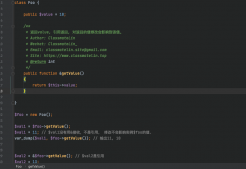本文实例讲述了php实现的Curl封装类Curl.class.php用法。分享给大家供大家参考。具体如下:
|
1
2
3
4
5
6
7
8
9
10
11
12
13
14
15
16
17
18
19
20
21
22
23
24
25
26
27
28
29
30
31
32
33
34
35
36
37
38
39
40
41
42
43
44
45
46
47
48
49
50
51
52
53
54
55
56
57
58
59
60
61
62
63
64
65
66
67
68
69
70
71
72
73
74
75
76
77
78
79
80
81
82
83
84
85
86
87
88
89
90
91
92
93
|
<?php//curl类class Curl{ function Curl(){ return true; } function execute($method, $url, $fields='', $userAgent='', $httpHeaders='', $username='', $password=''){ $ch = Curl::create(); if(false === $ch){ return false; } if(is_string($url) && strlen($url)){ $ret = curl_setopt($ch, CURLOPT_URL, $url); }else{ return false; } //是否显示头部信息 curl_setopt($ch, CURLOPT_HEADER, false); // curl_setopt($ch, CURLOPT_RETURNTRANSFER, true); if($username != ''){ curl_setopt($ch, CURLOPT_USERPWD, $username . ':' . $password); } $method = strtolower($method); if('post' == $method){ curl_setopt($ch, CURLOPT_POST, true); if(is_array($fields)){ $sets = array(); foreach ($fields AS $key => $val){ $sets[] = $key . '=' . urlencode($val); } $fields = implode('&',$sets); } curl_setopt($ch, CURLOPT_POSTFIELDS, $fields); }else if('put' == $method){ curl_setopt($ch, CURLOPT_PUT, true); } //curl_setopt($ch, CURLOPT_PROGRESS, true); //curl_setopt($ch, CURLOPT_VERBOSE, true); //curl_setopt($ch, CURLOPT_MUTE, false); curl_setopt($ch, CURLOPT_TIMEOUT, 10);//设置curl超时秒数 if(strlen($userAgent)){ curl_setopt($ch, CURLOPT_USERAGENT, $userAgent); } if(is_array($httpHeaders)){ curl_setopt($ch, CURLOPT_HTTPHEADER, $httpHeaders); } $ret = curl_exec($ch); if(curl_errno($ch)){ curl_close($ch); return array(curl_error($ch), curl_errno($ch)); }else{ curl_close($ch); if(!is_string($ret) || !strlen($ret)){ return false; } return $ret; } } function post($url, $fields, $userAgent = '', $httpHeaders = '', $username = '', $password = ''){ $ret = Curl::execute('POST', $url, $fields, $userAgent, $httpHeaders, $username, $password); if(false === $ret){ return false; } if(is_array($ret)){ return false; } return $ret; } function get($url, $userAgent = '', $httpHeaders = '', $username = '', $password = ''){ $ret = Curl::execute('GET', $url, '', $userAgent, $httpHeaders, $username, $password); if(false === $ret){ return false; } if(is_array($ret)){ return false; } return $ret; } function create(){ $ch = null; if(!function_exists('curl_init')){ return false; } $ch = curl_init(); if(!is_resource($ch)){ return false; } return $ch; }}?> |
GET用法:
|
1
2
|
$curl = new Curl();$curl->get('http://www.XXX.com/'); |
POST用法:
|
1
2
|
$curl = new Curl();$curl->get('http://www.XXX.com/', 'p=1&time=0'); |
希望本文所述对大家的php程序设计有所帮助。













